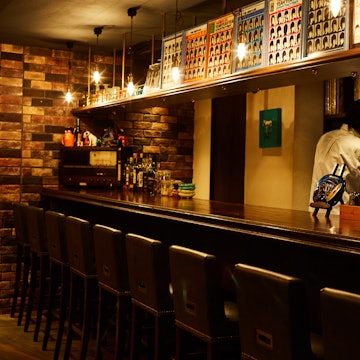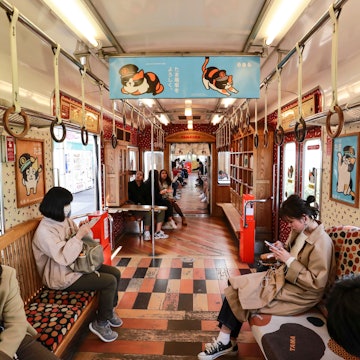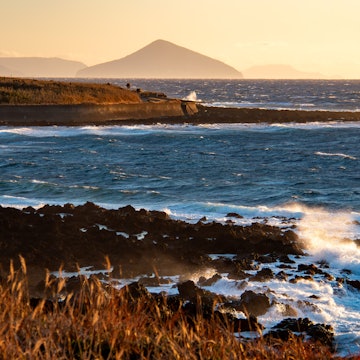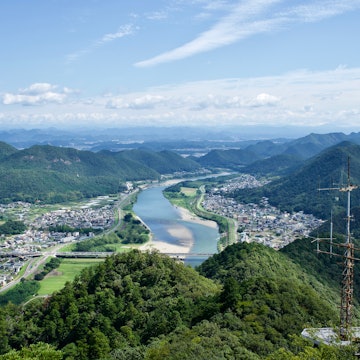
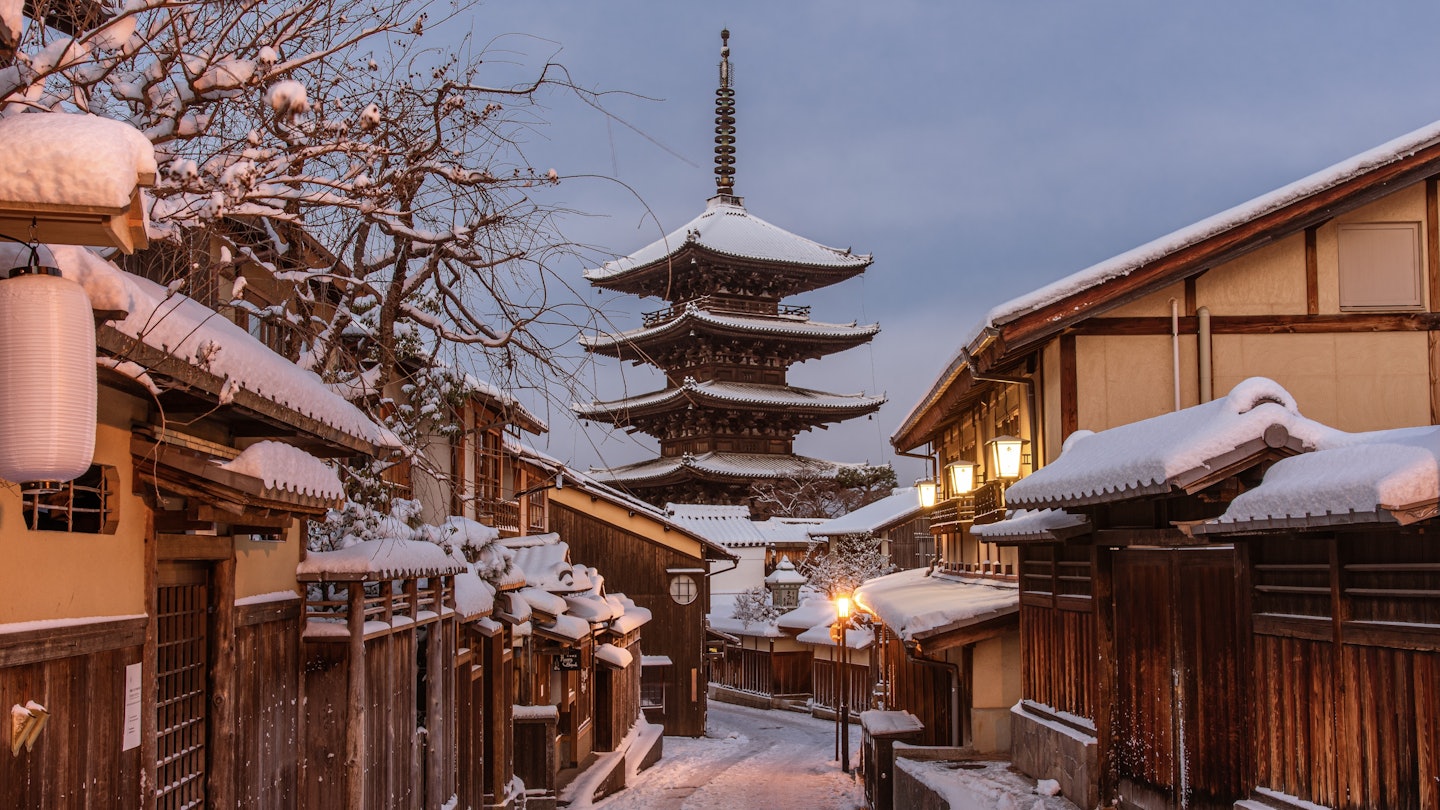
Sannenzaka and the Yasaka Pagoda on a winter evening, Kyoto. ZHAN XUNCHAO/Shutterstock
One of Japan’s best-preserved cities, Kyoto is a must-see destination – at any time of the year.
As the country’s capital for a millennium (794–1868), the city blossomed not just as a seat of power but also as a religious and cultural center where shrines, temples, gardens and geisha (known locally as geiko) districts were established alongside palaces and castles, often amid outstanding natural beauty.
These historical and cultural sites are especially impressive come spring, when cherry blossom trees are transformed into swathes of pink and white blooms; and in fall, when trees turn vibrant shades of crimson, orange and gold. You’ll need to book well ahead for these peak seasons and be prepared for crowds and queueing.
Low season is mid-December to February, and many businesses close during the year-end and New Year holidays. There are also fewer visitors during the summer, when the weather is hot and humid and there is the possibility of typhoons.

March to April is best for cherry blossoms
Early spring brings mild, relatively dry weather, with an average high temperature of 19˚C (66˚F) and average low of 8˚C (46˚F). The warm afternoons are ideal for spending time outdoors, but it’s best to carry an extra layer for the cooler mornings and evenings.
Sakura, or cherry blossoms, reach full bloom between late March and mid-April. People gather for hanami (flower viewing) picnics under the flowers, take strolls and spend time relaxing in scenic spots. Options include Maruyama-kōen, known for its large weeping cherry tree, and Nijō-jō, whose grounds feature more than 300 cherry trees of 50 varieties. For a scenic stroll on a stone trail lined with blossoms, head to the Path of Philosophy – just be prepared for crowds.
A hidden gem is the cruise along the Lake Biwa Canal from the city’s Keage or Yamashima ports to Ōtsu on the shores of Lake Biwa, a 50-minute journey providing views of the blooms from a different perspective.
Planning tip: Before you depart, check Kyoto’s cherry blossom live calendar, which features the peak viewing times from previous years and the percentage of bloom at various attractions.

May to June is best for nature and indoor activities
The mercury rises slightly in May, creating ideal conditions for exploring the outdoors. Arashiyama, to the west of the city, is a cycling-friendly environment boasting historic sites, a monkey park and a bamboo grove. Be sure to disembark for a stroll along the grove’s pedestrianized main path, where sunlight filters through the thousands of towering bamboo stalks as they sway in the breeze. For hiking, a popular option is Fushimi Inari-Taisha, a mountainous shrine made famous by the long line of vermillion torii gates that leads to the sanctuary.
With the arrival of tsuyu (rainy season) in early June, vegetation begins to thrive. Though Kyoto is renowned for its autumnal maple leaves, the lush green maples are a refreshing sight, particularly at Jingo-ji, which holds several National Treasures; and Tōfuku-ji, a Zen Buddhist temple with large eaves to shelter from showers. At Sanzen-in, meanwhile, some 1000 hydrangeas brighten up the grounds in purple, pink and blue shades.
On days with heavy downpours, cultural options for indoor activities include the Kyoto National Museum, Kyoto City KYOCERA Museum of Art and Kyoto Handicraft Center. Covered arcades such as Teramachi and Shinkyōgoku offer shopping and dining.
Planning tip: Hotels are especially busy during the series of public holidays in early May, so book early and expect inflated prices.
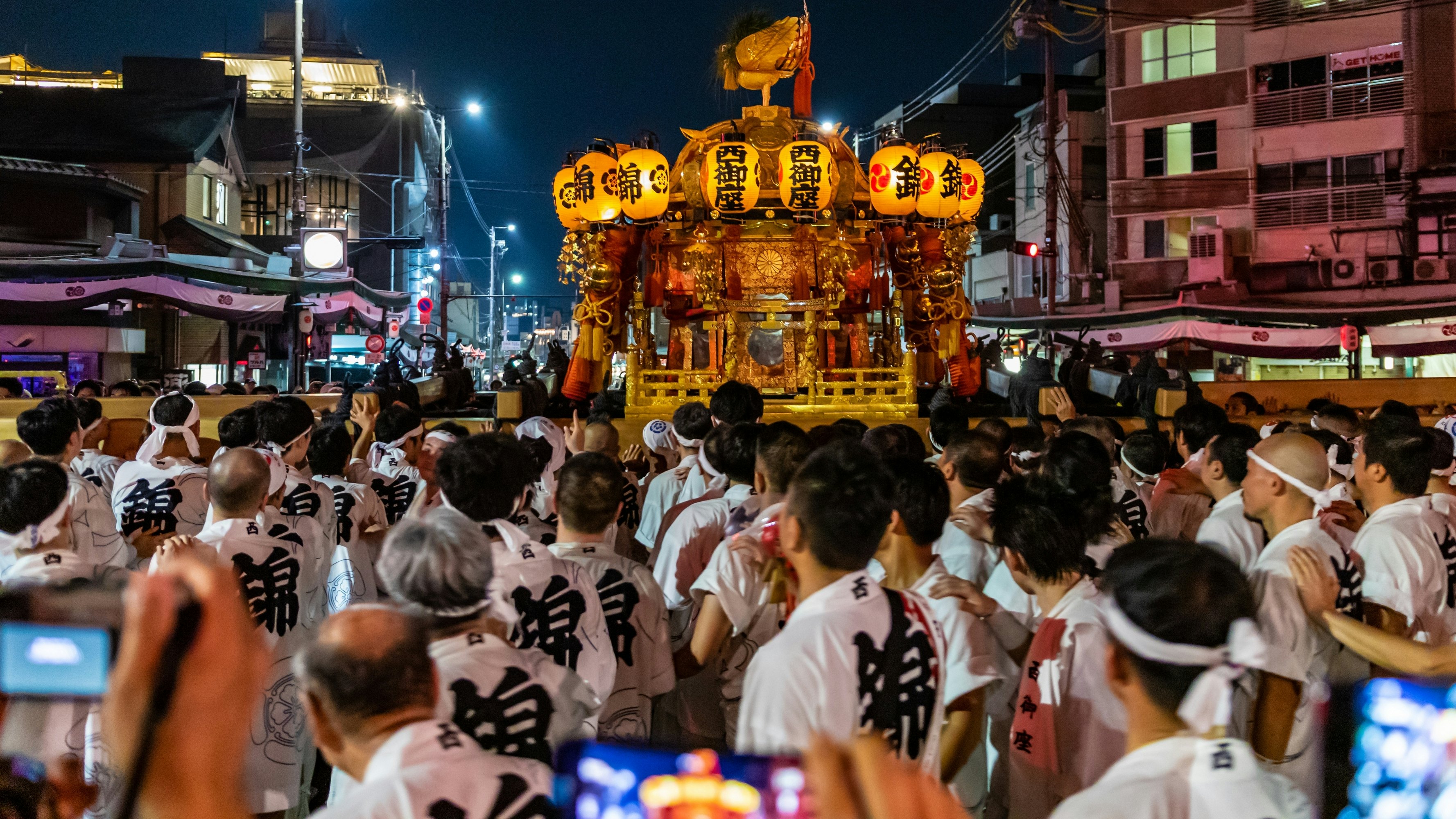
July to October is best for festivals
As Kyoto is situated in a basin with mountains on three sides, heat and humidity can be oppressive in summer, with average high temperatures of 32˚C (89˚F). Be sure to drink plenty of water or sports drinks and find some shade or cover up during the hottest part of the day. In the evenings, the city comes alive with color and sound as residents hold vibrant festivals and events to honor their ancestors, pray for good harvests or simply to enjoy the season.
In July, the downtown area hosts the Gion Matsuri, one of the oldest festivals in Japan. Floats and portable shrines are paraded through the streets and houses open their doors to display folding screens. Amid the revelry, vendors sell traditional street food such as yakitori, takoyaki (battered octopus) and shaved ice topped with sweet syrup, as attendees stroll in yukata (summer kimono).
Attention turns to nature in August as giant fires set in the shape of kanji characters are lit on the side of five mountains near the city. In a tradition of intangible cultural heritage, the fires are intended to guide spirits who have been visiting residents back to the afterlife.
The International Manga Anime Fair is held in September, while October brings the Jidai Matsuri, a procession of some 2000 costume-clad participants, often on horseback. Designed to showcase the city’s history while it was the capital of Japan, the parade travels from the Imperial Palace to Heian Jingū shrine, providing ample opportunity to get a glimpse of the action.
Local tip: Escape some of the heat with riverside dining, a tradition that dates back to the 16th century. In Kibune, restaurants called kawadoko protrude over the river, providing a refreshing breeze and a picturesque view.

November to December is best for autumn leaves
While the peak viewing period for fall foliage varies across the city depending on altitude and sun exposure, mid-November is typical, with some areas seeing the most vibrant colors in late November and early December.
In central Kyoto, Kiyomizu-dera temple offers sweeping scenes of red, orange and yellow leaves from the 12m-high (39ft-high) wooden stage that protrudes from its main hall. Tenryu-ji is another prime viewing spot, with its Sogenchi Pond providing a reflection of the colors.
In the hills to the west, Yoshimine-dera temple’s sprawling grounds offer some respite from the inevitable crowds. Resplendent shades of crimson and bronze leaves can be found not only in the gardens but also in the picturesque forested backdrop.
Local tip: Check out the autumnal colors in the evening, too. Eikan-dō and Kōdai-ji are among the temples illuminated with thousands of lights, creating a magical ambiance.

January to February to best for snowy views and warming matcha
The city’s historic landmarks look especially impressive in the snow, though the city is rarely blanketed in white, despite the mercury typically reaching as low as 5˚C (41˚F) during daytime.
For snowy views, it’s best to head to higher ground such as Ōhara. At Kifune Shrine, the red lanterns lining the ancient path create a soft glow and provide a dramatic contrast to the white snow. A trip on the Eizan cable car up Mt Hiei is also popular to enjoy scenic snowscapes.
If you’d rather keep warm indoors, make the short trip to Uji, widely considered the birthplace of matcha in Japan. The town’s lively shopping street, Byōdō-in Omotesando, has several cafes and sweet shops where you can enjoy traditional refreshments while watching snowflakes fall.
Local tip: Bathing in an onsen is a popular way for locals to warm up. Most facilities offer toiletries and towels free of charge or to rent, making a quick soak a practical and rejuvenating experience to try while exploring.










